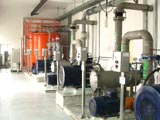
Case Study: One Technology, Three Applications
Advances in RO Increase Utility of Wastewater in Water-short Beijing
- By Niann-Tsyr Yuen
- Oct 03, 2008
China's capital city has a long history of water scarcity. In recent years, rapid economic growth, pollution, and a population reaching 17 million have intensified the problem. It is estimated that Beijing's water availability per capita is 30 times below the international average.
When Beijing was awarded the 2008 Summer Olympics in 2001, it had seven years to make major changes to accommodate new infrastructure and an estimated 3 million visitors. Beijing also would need more water prior to the games to support an influx of migrant workers and major construction projects. Experts pegged the additional water needs at 4.7 million m3 per day.
To meet that need, Beijing officials set an ambitious goal: reclaiming and reusing a full 50 percent of the city's wastewater by the time the Olympics would begin in August 2008.
For several high-profile Olympic projects, including the now-famous dragon-shaped Capital Airport Terminal 3 and green sculptures in the Olympic Garden, city officials selected FILMTEC™ fouling-resistant (FR) reverse osmosis (RO) membranes from Dow Water Solutions.
RO filtration enables advanced wastewater treatment and re-use for three very distinct and different purposes in Beijing -- infrastructure support, green industry, and landscape beautification.
Beijing completed a 245-acre addition to its Capital Airport in early 2008. It's the largest airport building in the world. A dedicated wastewater treatment facility uses these membranes to purify and reuse approximately 10,000 m3/d of water for irrigating its green belt, cleaning, and supporting infrastructure like bathroom plumbing.
In the Beijing Economic-Technological Development Area (BDA), a model for sustainable industrial growth with an emphasis on green solutions, the membranes are enabling wastewater reclamation of 20,000 m3/d for electronic, pharmaceutical, and other industrial process uses.
At the BeiXiaoHe Wastewater Treatment Plant, the membranes enable reclamation and reuse of 10,000 m3/d of water to fill the fountains and pools and irrigate the landscapes in the Olympic Park.
In all three applications, FILMTEC™ FR membranes enable a recovery rate of 75 to 80 percent of water – a high margin for wastewater reclamation through RO and due largely to a reduction in biofouling. Biological materials adhering to the walls of the RO membrane and feed spacer is called biofouling, which blocks water flow and causes downtime for chemical cleanings. It's a particular problem when dealing with wastewater, which has a much higher concentration of biologicals than ground or surface water.
Dow's RO technology has several features that make it suitable for the Beijing applications:
Fewer chemical cleanings. The elements maintain performance with three fewer chemical cleanings per element per year on average, which can save an estimated U.S. $180 per element/year. With some 5,000 elements supporting Beijing's wastewater reclamation efforts, the potential cost savings to the city over a three-year useful life is almost U.S. $3 million. Actual savings will be influenced by site-specific conditions.
Extended useful life before replacement. The elements are designed to withstand repeated chemical cleanings, making them more durable in wastewater applications. A shorter leaf length achieves more uniform flux distribution and the spacer design maximizes chemical cleaning efficiency. Each leaf has no more than 0.25 inches [0.63 cm] of edge past the glue line. This minimizes the dead space available for bacteria to accumulate and propagate. Compared to conventional RO elements, this technology increases an element's useful life before replacement by an estimated 30 percent.
Reduction in power cost. A lower rate of biomass accumulation and biofouling of an element results in lower average feed pressure to operate, thus lowering energy cost. For example, at U.S. $0.10/KWH, the additional cost due to an increase in feed pressure of 25 psig (at pump efficiency of 75 percent) is about U.S. $7,000 per year.
In 2007, the Beijing Organizing Committee for the Games of XXIX Olympiad reported that Beijing not only achieved its goal of 50 percent wastewater reuse but has exceeded it. The city currently treats 92 percent of its wastewater for a reuse rate of 60 percent. Water experts say Beijing now has the highest water reuse rate in the country.
Population growth and rapid industrialization are making reverse osmosis technology a mission-critical component in meeting the potable and non-potable water needs of emerging economies like China.
About the Author
Niann-Tsyr Yuen is the Asia Pacific Marketing manager for FILMTEC(TM) Reverse Osmosis and Nanofiltration products for Dow Water Solutions. NT joined the company in 1996 as account manager for Malaysia and Singapore. He assumed his current role in 2001. In 2004, he relocated due to the rapid growth in the China water treatment market.